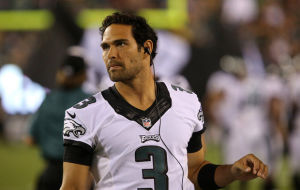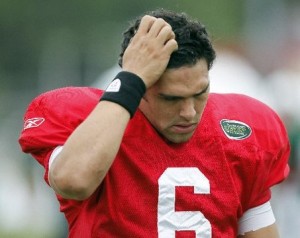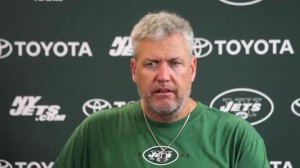My post for the New York Times this week takes a look at the triumvirate of Mike Tannenbaum, Rex Ryan, and Mark Sanchez.
Rex Ryan was hired by Mike Tannenbaum on Jan. 19, 2009. Three months later, they traded up in the 2009 N.F.L. draft to acquire Mark Sanchez. Since that moment, the three of them — the general manager, the head coach and the franchise quarterback — have had their fates intertwined. When the Jets made the A.F.C. championship game in their first season together, they far exceeded expectations, reaching that level far sooner than expected.
In the following off-season, Tannenbaum became the toast of the N.F.L. as he acquired four veterans – Santonio Holmes, LaDainian Tomlinson, Jason Taylor, and Antonio Cromartie — to help put the Jets over the proverbial hump. In August, it was Ryan’s turn to steal the spotlight, as he became a national sensation and the coach everyone wanted to play for following his appearance on HBO’s “Hard Knocks.” During the season, it was Sanchez’s time to shine, as he led the Jets on game-winning drives in the fourth quarter or overtime in six different games, the highest number in the league. The Jets won 11 games and went back to the A.F.C. championship game, but again, were stuck at the Super Bowl’s doorstep.
That was the high-water mark of the Tannenbaum-Ryan-Sanchez era. The Jets regressed to 8-8 last season and with a 3-5 record in 2012, appear to be continuing in a downward spiral. With Tannenbaum, Ryan, and Sanchez forever linked, the question the Jets will have to answer at the end of the season is whether all — or any — of them are the right men to take the Jets back to the Super Bowl.
The Quarterback
Statistically, Sanchez has been a disappointment his entire career with the Jets. On the field, he has struggled with reading defenses and throwing accurate passes, and as a result, he is ranked below the league average in completion percentage and yards per attempt in each of his four seasons in the N.F.L. Only 18 quarterbacks in N.F.L. history have ranked below league average in those categories while playing for the same team in three consecutive years. Perhaps surprisingly, all but three — Joe Ferguson, Mark Malone, and an aging Marc Bulger — returned to the same team for a fourth season.
Of the remaining 15, one was Phil Simms, who tore his knee in the 1982 preseason, ending his streak of mediocre play. It wasn’t until he turned 30 that Simms had his first statistically solid season in 1985. David Woodley returned to Miami but lost his job to Dan Marino. Kyle Boller went back to Baltimore, but Steve McNair was acquired to replace him. Sanchez and Matt Cassel each received a fourth year in 2012 to prove themselves.
That leaves 10 quarterbacks who had three straight years of below average play in both yards per attempt and completion percentage, and were brought back by their team and remained as starters. Five quarterbacks — Donovan McNabb, Tobin Rote, Jim Hart, John Elway, and Drew Bledsoe — responded with above-average seasons in their fourth year in at least one of the two categories.
The other five? All again finished below average in the two categories for a fourth straight season. Mike Phipps in Cleveland, Rick Mirer in Seattle, Trent Dilfer in Tampa Bay and Joey Harrington in Detroit were the first four; the fifth was Eli Manning. I excluded Manning’s rookie season because he did not have enough pass attempts to qualify, but technically, he finished below average in both completion percentage and yards per attempt in each of the first five seasons of his career.
Sanchez currently ranks 33rd in completion percentage and 31st in yards per attempt, so absent Peyton Manning wearing his jersey for the rest of the year, Sanchez is going to finish below average for the fourth straight season in both categories. In Kansas City, Matt Cassel may match his streak, although his days with the Chiefs are numbered.
Can the Jets justify starting Sanchez in Year 5? If previous examples are considered, it’s doubtful. Mike Phipps, like Sanchez, was a top-five pick a franchise gambled on. In fact, Cleveland traded the future Hall of Fame wide receiver Paul Warfield to Miami to acquire Phipps, so the Browns were very hesitant to admit their mistake. In his fifth year, Phipps entered the season as the starter but an injury in the season opener against the Jets allowed Brian Sipe to take the job. Mirer was also a top-five pick, but after his fourth year, the Seahawks traded him to the Bears. Somehow, they were able to package him with a fourth-round pick for Chicago’s first-round selection. Tampa Bay, a team that was able to win despite its poor quarterback play because of a great defense, kept Dilfer as the starter in his fifth year, although an injury paved the way for the team to move on. Detroit traded Harrington after his fourth season to Miami for a late round pick. And while Manning’s individual statistics were not impressive, he had already won a Super Bowl with the Giants, ending any questions about his job security.
If the Jets go into the 2013 season with Sanchez as the starter, they will essentially be giving him as long a leash as any quarterback in N.F.L. history has ever had. There are obviously other considerations with Sanchez. He will cost the Jets salary cap over $17 million if they release him before the start of the 2014 season. As it stands, the Jets will pay him nearly $13 million in 2013. But it’s the extreme exception to the rule for a quarterback to have four consecutive years of mediocre play be given the starting job in his fifth year on a silver platter. When a highly drafted quarterback struggles so consistently and fails to develop, there are usually severe ramifications. And they extend far beyond the quarterback.






